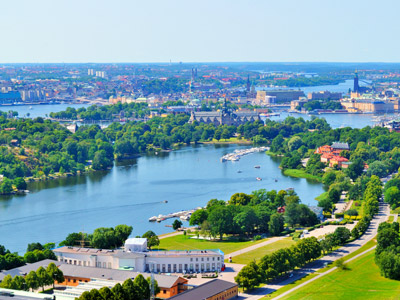Science fiction loves scaring people with gloomy visions of a dystopian future. Filmmakers this past year seemed especially fond of depicting future catastrophes. And nothing excites a filmmaker’s fertile imagination more than painting the cities of the future in images evocative of early Dutch painter Hieronymus Bosch.
Blade Runner’s night city, dripping with acid rain and lit only by garish neon, may be the prototype, but each filmmaker, each novelist can find new variations on the theme of nightmare cities. It’s hard to find any artist with an optimistic view of the future these days.
Are we condemned to witness disintegrating cities, or is there some hope that we can create urban conglomerations that we would actually like to live in? That is the daunting challenge of “smart cities”.
The complexity of smart cities

Though the term has become increasingly familiar, the definition of a “smart city” remains controversial. While the overall goal is generally perceived to be an ideal fusion of sustainability with advanced technology, there is confusion about where the term “smart” fits alongside “sustainable” and “resilient”.
Many vital spheres are included in any laundry list of what a smart city should address to improve economic development and the quality of life of its residents. User-friendly transportation and smoothly running road networks, energy efficiency, pollution-free air, clean water and efficient waste management, an environmentally sensitive setting, and effective measures taken to protect the safety and security of its citizens.
Above and beyond these practicalities, ideals of social equality and community harmony may also be aspirations for good urban living. These factors are part and parcel of the goal of making the lives of people living in those cities more productive and more agreeable.
Getting plugged in
An up-to-date infrastructure is essential to realizing all these objectives, and calls for the implementation of state-of-the-art information and communication technology (ICT). The proverbial “smart city” will therefore have optimal ICT embedded in both public and private sectors to improve professional and private lives.
But ICT must be a servant. A vital servant, but not one to take precedence over other significant players. Too often, ICT is seen as the be-all and end-all of smart cities, which only contributes to alienating other sectors and causing them to disengage from the conversation.
An example of the role ICT will play in the future has been provided by the European Union (EU). The EU has invested heavily in devising a strategy for achieving “smart” urban growth for its metropolitan city-regions, and has accordingly developed a range of programmes under Europe’s Digital Agenda.
In 2010, it highlighted its focus on strengthening innovation and investment in ICT to improve public services. The leading consultancy firm Arup Group Ltd. estimates that the global market for smart urban services will reach USD 400 billion per annum by 2020. Successful examples of smart city technologies and programmes have been implemented in Southampton, in the UK, as well as in Vienna, Amsterdam, Barcelona and Stockholm.
Shifting demographics

The United Nations Population Fund (UNFPA) warns us that we are witnessing the largest wave of urban growth in history. Most of the world’s poor live in rural areas. Through migration – both voluntary and refugee – the rural poor are among the main contributors to the rapid increase in urban populations observed in most developing countries.
More than half of the world’s population now lives in towns and cities, and by 2030, the UNFPA estimates that this number will swell to about five billion. Much of this urbanization will unfold in Africa and Asia, bringing potentially cataclysmic social, economic and environmental upheavals. Poor migrants face intractable difficulties: unemployment and general insecurity among underprivileged urban inhabitants can lead to devastating increases in crime and civil unrest.
Young people also abandon rural communities in both developing and developed countries, leaving home in droves to seek employment, greater opportunities and sometimes sanctuary in the world’s towns and cities. And the needs of an ageing population, notably health care and mobility, also must be factored in. But this exponential growth, these new considerations, place an enormous burden on already stretched urban resources, adding to the pressures to which “smart cities” need to respond.
Smart Cities Council
As migration to cities grows exponentially, the Smart Cities Council (SCC) can help cities get onto (or back to) the right track, assisting them in coping with the needs of an ever-expanding population base.
The SCC observes the differences between cities and regions around the world. When ISOfocus asked SCC Chairman Jesse Berst about the differences in approach across the globe, the answer was categorical: “Many cities in Europe, China and the Middle East are much further down the smart city path. They are aided by large government investments and a much greater sense of urgency. They understand that they are competing with other cities for jobs and talent. And that being a smart, connected, sustainable city gives them a tremendous competitive advantage while greatly improving the lives of their citizens.”
 Click to zoom
Click to zoomThe SCC is a coalition of the world’s foremost smart city practitioners and innovators focused on livability, workability and sustainability. The Council’s goal is to accelerate the growth of smart cities worldwide by providing city leaders with best practices and vendor-neutral guidance on technology, finance, policy and citizen engagement.
Moreover, the SCC hosts the Internet’s most popular independent smart-city Website and is considered the leading reference for smart-city tools. It also organizes events worldwide – forums, workshops and their first Smart Cities Week event in September 2015 in Washington, D.C. The Council is advised by, among others, unbiased, independent experts from academia, climate advocacy groups and development banks. The American National Standards Institute (ANSI), ISO member for the USA, sits on their Advisory Board.
What difficulties does the SCC foresee and how will a transformation into smart cities help? Berst observes: “We’re all familiar with urban challenges such as congestion, crime, pollution and income inequality. We can no longer build our way out of these problems with last-century 'dumb' infrastructure. We must tap the power of digital technology.”
Moving from this premise, what expectations does the SCC have and how can standards help? “Cities badly need a way to assess where they are, aim for where they need to be and measure their progress along the way,” says Berst. “Standards fill that need. Equally important, they are the first step toward the holy grail of an interoperable, plug-and-play world where cities can mix and match solutions from different vendors without fear of lock-in or obsolescence or dead-end initiatives.” This is a much needed step forward from the current state of affairs where it is easy to get the impression that obsolescence is built in.
City-needs approach

ISO’s involvement and interest in this timely issue led to the creation of the ISO Technical Management Board’s Smart City Strategic Advisory Group (SAG). ISOfocus asked Graham Colclough, Chair of the SAG, about the importance for standards development organizations to coordinate their work.
A recognized thought leader on issues of technology enablement for public services, Colclough recently initiated a survey for the SAG on the topic. “ I was keen to take a city-needs-led approach. One must think first from the ultimate consumer’s point of view or one is a fool from the outset.”
In this spirit, the SAG asked 20 countries to enrol half a dozen cities to glean their opinion on certain questions. The analysis of results is still being processed, but it is clear that the SAG’s hypothesis that standards are not of primary interest to city leaders is validated.
Colclough analyses: “Cities are not aware of materials coming from standards bodies. They think of themselves as unique, so the concept of standardization doesn’t fit their line of thinking.” Yet, he says, “there are systemic similarities among all cities”. Cities seem to view standards as technical details or constraints, not aids to advancement. For the SAG Chair, it is a question of repositioning what standards mean to cities and then repositioning what standardization bodies should be doing together to be more relevant, particularly for cities of modest size.
Bringing cities up to standard
The Association française de normalisation (AFNOR), ISO’s member for France, took the initiative of establishing ISO technical committee ISO/TC 268, Sustainable development in communities, which it also chairs. It develops a wide range of standards on sustainable development in communities, including standards on indicators for smart cities and for smart infrastructures.
More than 50 % of the world’s population now lives in towns and cities.
The committee’s consensus is that sustainable development is the overarching goal, while smartness is one of the means to achieve it. Bernard Leservoisier, Standardization Programme Manager at AFNOR and Secretary of ISO/TC 268, captures it perfectly. Rather than “smart city”, he suggests, “it is more accurate to talk about smart infrastructures, smart services, smart systems, smart devices, smart equipment, etc. in a city ”.
“Smartness will help cities become more effective,” he continues. “It will help them develop integrated and interconnected strategies or systems that they will be able to monitor on a real-time basis.” Of course, this is only possible by resorting to high technology that all cities may not be able to afford or maintain – hence the reluctance of certain developing countries. Besides, since those smart systems will collect a lot of personal data, this raises questions on the ownership and the security of data. On this point, Leservoisier cautions, “Smart solutions may help cities grow more effective, but they will prove disappointing if they are not sustainable.”
Smart systems must, therefore, be integrated into sustainable development approaches including, for example, good governance, security, financial efficiency, effective management of energy and resources, environmental preservation, and climate change mitigation and resilience, among others.
A guide for managers

To give practical guidance to urban planners, ISO/TC 268 has undertaken the task of drafting ISO 37101, Sustainable development of communities – Management systems – Requirements with guidance for resilience and smartness.
While it does not deal with smart cities directly, the standard aims at helping communities develop and implement management systems to improve their performance in sustainable development. Smartness and resilience are considered means, among others, that will help communities – and by extension the towns and cities in which they are located – become more sustainable.
Underscoring the importance of ISO’s mission in this domain, Leservoisier states, “ISO has a crucial role to play in fostering harmonization and clarification, and publishing documents that reflect international consensus and become globally relevant.” And indeed, the number of standards and reference documents, be they elaborated at the international, regional or national levels, keeps on growing.
ISO can, therefore, facilitate the exchange of expertise and best practices, stimulate innovation and help cities procure more cost-effective and reliable systems that meet their genuine needs.
Tomorrowland
ISO can help cities procure more cost-effective and reliable systems.
Between Hollywood’s murky crystal ball and the UNFPA’s findings, the cities of the future look potentially very disturbing. You don’t have to be one of Blade Runner’s human replicants to worry that time may be running out. As Colclough points out, “ISO’s working definition of smart cities starts with a 'call to arms' to dramatically increase the pace at which cities must address these issues.”
So the multidisciplinary “architects” (and standardizers among them) of smart cities have their work cut out for them. The challenges will be endless, the repercussions as yet hard to anticipate, with many unpleasant surprises along the way. But the potential rewards for residents to enjoy a “livable” world full of “livable” cities are nothing short of ensuring a progressive future for humanity. Now, that’s smart!

